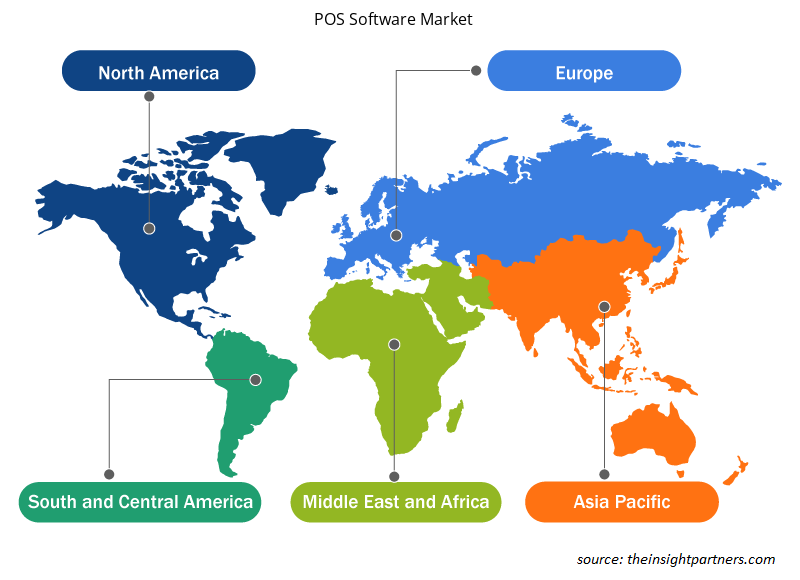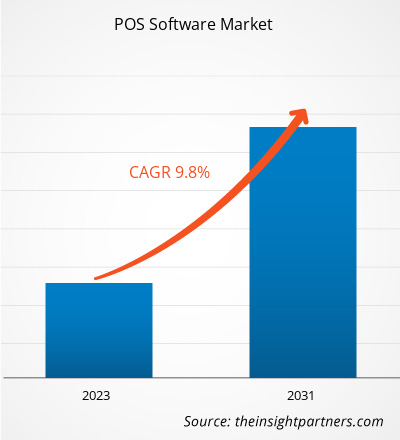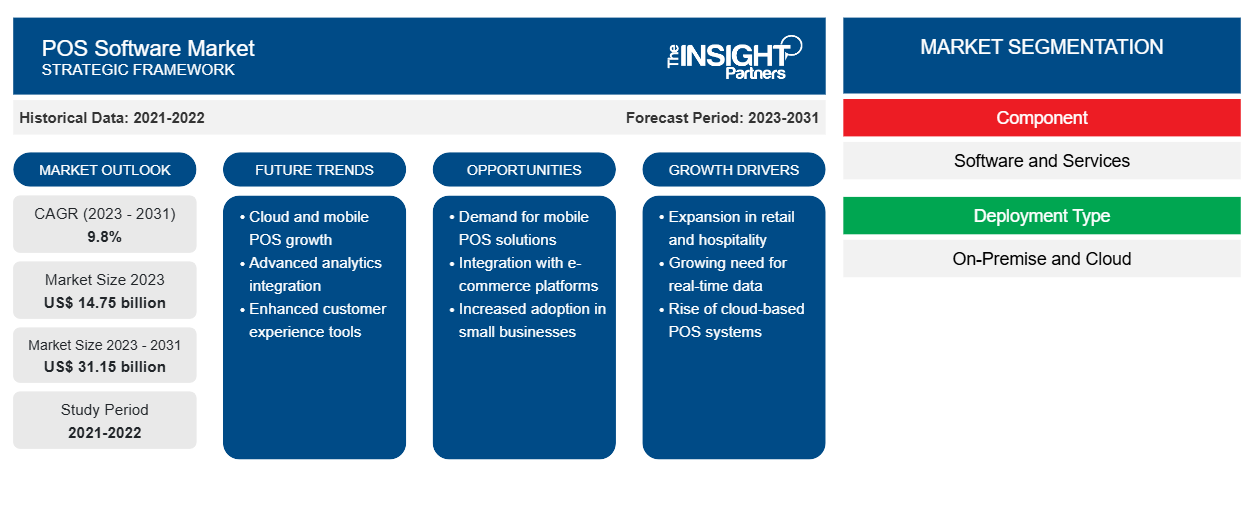Se proyecta que el tamaño del mercado de software POS alcance los US$ 31,15 mil millones para 2031 desde US$ 14,75 mil millones en 2023. Se espera que el mercado registre una CAGR del 9,8% entre 2023 y 2031. Es probable que el uso creciente de servicios de computación en la nube siga siendo una tendencia clave del mercado de software POS.
Análisis del mercado de software para puntos de venta
La necesidad de realizar transacciones sin efectivo, realizar un seguimiento de las ventas y los datos de inventario y aprovechar los análisis para optimizar la estrategia de ventas en cadenas minoristas, restaurantes, hoteles, farmacias, talleres de automóviles y otros lugares ha impulsado la demanda de software de punto de venta (POS). Se prevé que el uso de software de POS aumente en una variedad de industrias debido a la creciente demanda de capacidades avanzadas que incluyen la gestión de datos de clientes, el seguimiento de inventario, la supervisión de ventas, el análisis de la gestión de empleados y la elaboración de informes. Además, la creciente demanda de software de punto de venta móvil basado en la nube podría atribuirse a la creciente aceptación de soluciones basadas en la nube.
Descripción general del mercado de software para puntos de venta
El software de punto de venta (POS) es una aplicación especializada que las empresas utilizan para realizar transacciones en el punto de venta, generalmente en entornos minoristas. Al realizar un seguimiento de las ventas, controlar el inventario y gestionar los pagos, agiliza el proceso de pago. Para garantizar la precisión, el software de punto de venta con frecuencia interactúa con hardware como lectores de códigos de barras , cajas registradoras y lectores de tarjetas. Además, tiene herramientas para gestionar la información del cliente, crear informes de ventas y evaluar.
Personalice este informe según sus necesidades
Obtendrá personalización en cualquier informe, sin cargo, incluidas partes de este informe o análisis a nivel de país, paquete de datos de Excel, así como también grandes ofertas y descuentos para empresas emergentes y universidades.
-
Obtenga las principales tendencias clave del mercado de este informe.Esta muestra GRATUITA incluirá análisis de datos, desde tendencias del mercado hasta estimaciones y pronósticos.
Factores impulsores y oportunidades del mercado del software POS
Creciente industria del comercio electrónico
Con la creciente prevalencia de las compras en línea y omnicanal, las empresas necesitan un software de punto de venta (POS) capaz de conectar sin problemas sus canales de venta en línea y fuera de línea. Esto impulsa la demanda de sistemas de punto de venta (POS) que incluyan funciones como control de inventario, cumplimiento de pedidos y gestión de relaciones con los clientes (CRM), lo que está impulsando el crecimiento del mercado de software de POS.
Creciente demanda de inteligencia empresarial y análisis de datos
El software de punto de venta (POS) se está convirtiendo en una herramienta cada vez más popular que utilizan las empresas para recopilar y examinar datos sobre ventas, comportamiento de los clientes, inventario y rendimiento de los empleados. Las sofisticadas tecnologías de análisis e informes pueden ayudar a las empresas a tomar decisiones basadas en datos, aumentar la satisfacción de los clientes y reducir los procedimientos. Por lo tanto, se espera que estos beneficios del software de punto de venta impulsen el crecimiento del mercado en el período previsto.
Análisis de segmentación del informe de mercado de software de punto de venta
Los segmentos clave que contribuyeron a la derivación del análisis del mercado de software POS son componentes (software y servicios); tipo de implementación (en las instalaciones y en la nube); aplicación y usuario final.
- Según los componentes, el mercado de software para puntos de venta se divide en software y servicios. El segmento de software tuvo una mayor participación de mercado en 2023.
- Según el tipo de implementación, el mercado se divide en local y en la nube. El segmento local tuvo una mayor participación de mercado en 2023.
- Según la aplicación, el mercado se segmenta en seguimiento de inventario, gestión de compras, informes de ventas, interacción con el cliente y otros. El segmento de seguimiento de inventario tuvo una mayor participación de mercado en 2023.
- Por usuario final, el mercado se segmenta en comercio minorista, hostelería, medios de comunicación y entretenimiento, atención sanitaria y otros. El segmento minorista tuvo la mayor participación del mercado en 2023.
Análisis de la cuota de mercado del software POS por geografía
El alcance geográfico del informe del mercado de software POS se divide principalmente en cinco regiones:América del Norte, Asia Pacífico, Europa, Medio Oriente y África, y América del Sur/América del Sur y Central.
En términos de ingresos, América del Norte representó la mayor participación en el mercado de software de punto de venta. El mercado en esta región está segmentado en Estados Unidos, Canadá y México. La región cuenta con varios fabricantes de software de punto de venta conocidos, así como con una gran demanda de software de punto de venta integrado complejo. Además, la industria minorista está experimentando un enorme crecimiento en la región, lo que impulsa el crecimiento del mercado. Además, se espera que la industria de la atención médica de Estados Unidos crezca al ritmo más rápido debido a la necesidad de modernizar las instalaciones hospitalarias relacionadas con los seguros, los pagos y la gestión de pacientes.
Noticias y desarrollos recientes del mercado de software para puntos de venta
El mercado de software para puntos de venta se evalúa mediante la recopilación de datos cualitativos y cuantitativos a partir de investigaciones primarias y secundarias, que incluyen publicaciones corporativas importantes, datos de asociaciones y bases de datos. A continuación, se incluye una lista de los avances en el mercado de los trastornos del habla y el lenguaje y las estrategias:
- US Bank, líder de la industria en servicios de pago, anunció el lanzamiento de Avvance, una solución de préstamos en puntos de venta integrados y multicanal. Avvance brinda a las empresas la posibilidad de ofrecer financiamiento al consumidor durante el pago con una solicitud rápida y una toma de decisiones instantánea. (Fuente: Elavon Inc., comunicado de prensa, 2023)
- NCR Corporation ha presentado NCR Aloha Cloud, una solución de punto de venta (POS) basada en la nube que ofrece capacidades lo suficientemente sólidas como para llegar al mercado bajo la marca Aloha, líder en la industria. Aloha Cloud ofrece una interfaz de usuario (UI) renovada, el dispositivo portátil más pequeño del mercado y un procesamiento de pagos sin inconvenientes con financiación de depósitos al día siguiente, lo que brinda a los operadores más tiempo para concentrarse en la gestión de su restaurante. (Comunicado de prensa, 2022)
Perspectivas regionales del mercado de software de punto de venta
Los analistas de Insight Partners explicaron en detalle las tendencias y los factores regionales que influyen en el mercado de software de punto de venta durante el período de pronóstico. Esta sección también analiza los segmentos y la geografía del mercado de software de punto de venta en América del Norte, Europa, Asia Pacífico, Oriente Medio y África, y América del Sur y Central.

- Obtenga datos regionales específicos para el mercado de software POS
Alcance del informe de mercado de software de punto de venta
| Atributo del informe | Detalles |
|---|---|
| Tamaño del mercado en 2023 | 14.750 millones de dólares estadounidenses |
| Tamaño del mercado en 2031 | US$ 31.150 millones |
| CAGR global (2023 - 2031) | 9,8% |
| Datos históricos | 2021-2022 |
| Período de pronóstico | 2023-2031 |
| Segmentos cubiertos |
Por componente
|
| Regiones y países cubiertos |
América del norte
|
| Líderes del mercado y perfiles de empresas clave |
|
Densidad de actores del mercado de software POS: comprensión de su impacto en la dinámica empresarial
El mercado de software para puntos de venta está creciendo rápidamente, impulsado por la creciente demanda de los usuarios finales debido a factores como la evolución de las preferencias de los consumidores, los avances tecnológicos y una mayor conciencia de los beneficios del producto. A medida que aumenta la demanda, las empresas amplían sus ofertas, innovan para satisfacer las necesidades de los consumidores y aprovechan las tendencias emergentes, lo que impulsa aún más el crecimiento del mercado.
La densidad de actores del mercado se refiere a la distribución de las empresas o firmas que operan dentro de un mercado o industria en particular. Indica cuántos competidores (actores del mercado) están presentes en un espacio de mercado determinado en relación con su tamaño o valor total de mercado.
Las principales empresas que operan en el mercado de software POS son:
- Infor Inc
- Intuit, Inc.
- Velocidad de la luz
- Corporación Oracle
- Red Clover, LLC
- Corporación NCR
Descargo de responsabilidad : Las empresas enumeradas anteriormente no están clasificadas en ningún orden particular.

- Obtenga una descripción general de los principales actores clave del mercado de software POS
Informe sobre el mercado de software de punto de venta: cobertura y resultados
El informe “Tamaño y pronóstico del mercado de software de punto de venta (2023-2031)” proporciona un análisis detallado del mercado que cubre las siguientes áreas:
- Tamaño del mercado y pronóstico a nivel global, regional y nacional para todos los segmentos clave del mercado cubiertos bajo el alcance
- Dinámica del mercado, como impulsores, restricciones y oportunidades clave
- Principales tendencias futuras
- Análisis detallado de las cinco fuerzas de Porter y PEST y FODA
- Análisis del mercado global y regional que cubre las tendencias clave del mercado, los principales actores, las regulaciones y los desarrollos recientes del mercado.
- Análisis del panorama de la industria y de la competencia que abarca la concentración del mercado, el análisis de mapas de calor, los actores destacados y los desarrollos recientes
- Perfiles detallados de empresas
- Análisis histórico (2 años), año base, pronóstico (7 años) con CAGR
- Análisis PEST y FODA
- Tamaño del mercado, valor/volumen: global, regional y nacional
- Industria y panorama competitivo
- Conjunto de datos de Excel
Informes recientes
Informes relacionados
Testimonios
Razón para comprar
- Toma de decisiones informada
- Comprensión de la dinámica del mercado
- Análisis competitivo
- Información sobre clientes
- Pronósticos del mercado
- Mitigación de riesgos
- Planificación estratégica
- Justificación de la inversión
- Identificación de mercados emergentes
- Mejora de las estrategias de marketing
- Impulso de la eficiencia operativa
- Alineación con las tendencias regulatorias























 Obtenga una muestra gratuita para - Mercado de software POS
Obtenga una muestra gratuita para - Mercado de software POS